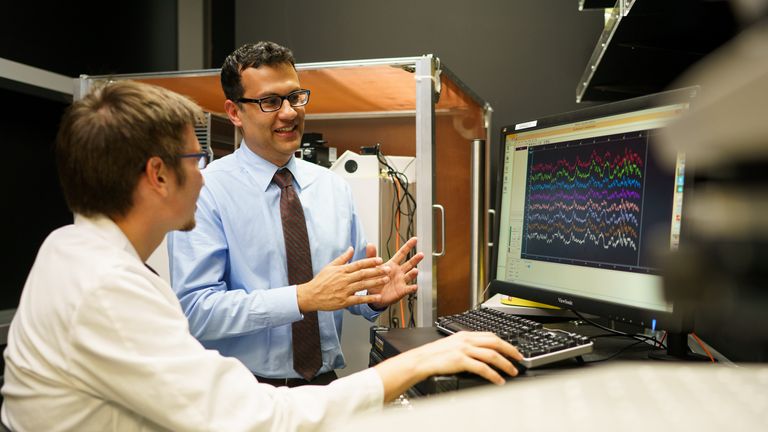A breakthrough in brain-controlled prosthetics could give paralysed individuals the ability to control computer cursors and potentially limbs in the future.
Using machine learning techniques, scientists were able to read brain signals simply by placing an array of electrodes on the surface of the brain.
It allowed the patient to control a computer cursor straight away, without the extensive daily retraining normally required.
Brain-control interfaces are a rapidly developing area of research, but while some remain critical of claims - such as those by Elon Musk, a number of trials are reporting significant findings.
In a peer-reviewed paper in Nature Biotechnology, scientists from the University of California, San Francisco (UCSF) were able to demonstrate so-called "plug and play" performance by using an electrocorticography (ECoG) array.
ECoG arrays are pads of electrodes about the size of a Post-it note that are surgically placed on the surface of the brain to record neural activity.
Unlike other brain-computer interface devices, which used so-called "pin-cushion" style arrays of sharp electrodes which penetrate the brain tissue, ECoG pads don't move in the brain, causing the signal they receive to change over time.
It means long-term stable recordings of neural activity can be logged, which allowed the team to develop an algorithm that recognised the patients' brain signals and matched them to their desired cursor movements.
"We found that we could further improve learning by making sure that the algorithm wasn't updating faster than the brain could follow - a rate of about once every 10 seconds," said Dr Karunesh Ganguly, a practising neurologist and author on the study.
"We see this as trying to build a partnership between two learning systems - brain and computer - that ultimately lets the artificial interface become an extension of the user, like their own hand or arm," he said.
Over the course of the study the participant's brain was able to amplify patterns of neural activity it could use to move the cursor via the ECoG array, while eliminating the less effective signals.
This pruning process is believed to be how the brain learns any complex task, according to the researchers, who said the participant's brain activity seemed to develop an ingrained and consistent mental "model" for controlling the interface.
Once the participant had established expertise in using the interface to move the cursor, the researchers were able to introduce additional learned skills - including clicking a virtual button - without losing any performance.
According to UCSF, the participant is "also enrolled in a clinical trial designed to test the use of ECoG arrays to allow paralysed patients to control a prosthetic arm and hand" - although this current paper only focused on controlling a cursor on a computer screen.
The study, titled "First 'plug and play' brain prosthesis demoed in paralysed person", is published in the journal Nature Biotechnology.
https://news.google.com/__i/rss/rd/articles/CBMibWh0dHBzOi8vbmV3cy5za3kuY29tL3N0b3J5L2ZpcnN0LXBsdWctYW5kLXBsYXktYnJhaW4tcHJvc3RoZXNpcy1kZW1vbnN0cmF0ZWQtaW4tcGFyYWx5c2VkLWluZGl2aWR1YWwtMTIwNjYwMTbSAXFodHRwczovL25ld3Muc2t5LmNvbS9zdG9yeS9hbXAvZmlyc3QtcGx1Zy1hbmQtcGxheS1icmFpbi1wcm9zdGhlc2lzLWRlbW9uc3RyYXRlZC1pbi1wYXJhbHlzZWQtaW5kaXZpZHVhbC0xMjA2NjAxNg?oc=5
2020-09-07 15:35:03Z
52781049206339

Tidak ada komentar:
Posting Komentar